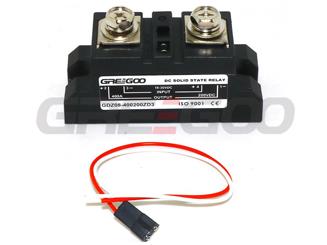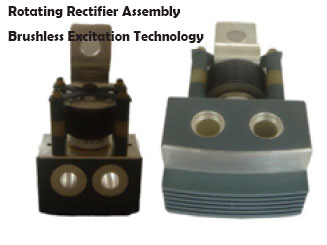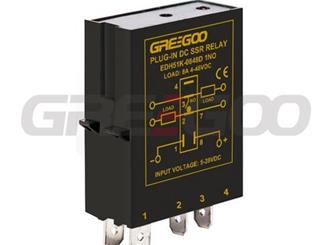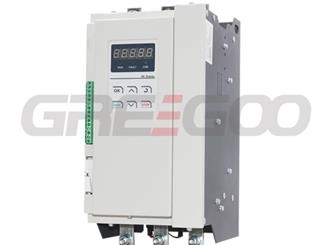Differences Between TRIAC Output SSR (GD series SSR) and SCR Output SSR (GDH series SSR)
Differences Between TRIAC Output SSR and SCR Output SSR
Core Component:
TRIAC Output SSR:
Uses a TRIAC (Triode for Alternating Current) as the primary power switching component.
TRIACs can conduct in both directions of an AC cycle, making them suitable for switching AC loads.
SCR Output SSR:
Uses SCRs (Silicon Controlled Rectifiers) as the power switching components, typically arranged in a back-to-back (anti-parallel) configuration to handle bidirectional AC current.
SCRs conduct in only one direction, requiring two SCRs to control AC loads effectively.
Current and Power Handling Capacity:
TRIAC Output SSR:
Typically suited for low to medium power applications, with current ratings generally ranging from 10A to 40A, ideal for small to medium loads (e.g., household appliances, lighting control).
Due to the TRIAC’s structural limitations, its heat dissipation and high-current handling capabilities are less robust compared to SCR configurations, making it suitable for lighter loads.
SCR Output SSR:
Designed for high-power applications, such as Greegoo’s GDH series, which supports current ranges from 40A to 120A, suitable for industrial-grade loads (e.g., motor control, heaters, large industrial equipment).
The dual SCR configuration (anti-parallel) provides superior thermal management and higher current handling, ideal for heavy loads and high-frequency switching.

Triac output vs SCR output SSR inner structure and marking comparison
Thermal Management and Durability:
TRIAC Output SSR:
TRIACs have simpler thermal management but may overheat during prolonged high-current operation due to their internal structure, potentially leading to a shorter lifespan.
Less durable in high-frequency switching or heavy-load applications compared to SCRs.
SCR Output SSR:
Utilizes dual SCR power hybrid technology (e.g., Greegoo’s GDH series), offering efficient thermal management and significantly improved cyclic life.
Better suited for high-frequency switching and heavy-load applications, reducing the risk of component damage due to overheating, thus enhancing durability.
Control Characteristics:
TRIAC Output SSR:
Commonly supports zero-crossing control, which reduces electromagnetic interference (EMI) and minimizes stress on the power grid, making it suitable for EMI-sensitive applications.
Random switching mode is less common in TRIAC SSRs due to simpler triggering mechanisms.
SCR Output SSR:
Supports both zero-crossing and random switching modes, offering greater flexibility.
SCRs can regulate current through phase control (adjusting the conduction angle), a feature typically not available in TRIAC SSRs, enabling finer power control in certain applications.
Application Scenarios:
TRIAC Output SSR:
Ideal for cost-sensitive, low to medium power applications, such as household appliances, lighting dimming, or fan control.
Commonly used in consumer electronics or light industrial applications due to lower costs.
SCR Output SSR:
Suited for high-power industrial applications, such as large motor control, industrial heaters, and HVAC systems.
Ideal for scenarios requiring high reliability, long lifespan, and high-frequency switching, especially in harsh environments or continuous operation.
Voltage Range:
TRIAC Output SSR:
Typically supports lower voltage ranges (e.g., 280V or below), with special designs required for higher voltages.
SCR Output SSR:
Supports higher voltage ranges, such as Greegoo’s GDH series, which handles 280V, 480V, and up to 660V (with a peak of 1200V), suitable for high-voltage industrial applications.
Cost and Complexity:
TRIAC Output SSR:
Simpler design and lower cost, as TRIACs are single components requiring less complex external circuitry.
Suitable for cost-sensitive applications but with performance limitations.
SCR Output SSR:
More complex design due to the need for dual SCRs in anti-parallel configuration and advanced triggering/isolation circuits (e.g., 2500Vrms optical isolation in Greegoo’s GDH series), resulting in higher costs.
Offers superior performance and reliability, ideal for high-end applications.
Summary
TRIAC Output SSR: Simple, cost-effective, and suitable for low to medium power AC load switching applications, particularly in consumer or light industrial settings. Limitations include lower performance and durability under high current/voltage and inability to regulate current.
SCR Output SSR: Uses dual SCRs, designed for high-power, high-voltage, and heavy-load applications with better thermal management, higher reliability, and longer lifespan. Supports both zero-crossing and random switching modes, and can regulate current, making it ideal for industrial applications but at a higher cost.
Greegoo's GDH series SCR output single phase solid state relay
The Greegoo GDH series, which utilizes SCR output for single-phase Solid State Relays (SSRs), includes a range of part numbers designed for AC switching with current ratings from 40A to 120A and load voltages of 280V, 480V, or 660V. For 40A, 60A, and 80A models, the part numbers are: GDH4028ZD1, GDH4028ZD3, GDH4028ZA2, GDH4028RD1, GDH4028RD3, GDH4028RA2, GDH6028ZD1, GDH6028ZD3, GDH6028ZA2, GDH6028RD1, GDH6028RD3, GDH6028RA2, GDH8028ZD1, GDH8028ZD3, GDH8028ZA2, GDH8028RD1, GDH8028RD3, GDH8028RA2 (for 280V); GDH4048ZD1, GDH4048ZD3, GDH4048ZA2, GDH4048RD1, GDH4048RD3, GDH4048RA2, GDH6048ZD1, GDH6048ZD3, GDH6048ZA2, GDH6048RD1, GDH6048RD3, GDH6048RA2, GDH8048ZD1, GDH8048ZD3, GDH8048ZA2, GDH8048RD1, GDH8048RD3, GDH8048RA2 (for 480V); and GDH4066ZD3, GDH6066ZD3, GDH8066ZD3 (for 660V). For 100A and 120A models, the part numbers are: GDH10028ZD1, GDH10028ZD3, GDH10028ZA2, GDH10028RD1, GDH10028RD3, GDH10028RA2, GDH12028ZD1, GDH12028ZD3, GDH12028ZA2, GDH12028RD1, GDH12028RD3, GDH12028RA2 (for 280V); GDH10048ZD1, GDH10048ZD3, GDH10048ZA2, GDH10048RD1, GDH10048RD3, GDH10048RA2, GDH12048ZD1, GDH12048ZD3, GDH12048ZA2, GDH12048RD1, GDH12048RD3, GDH12048RA2 (for 480V); and GDH10066ZD3, GDH12066ZD3 (for 660V). These part numbers reflect various control voltages (4-16Vdc, 3-32Vdc, 90-280Vac) and switching types (Zero-crossing or Random).
Greegoo's GD series TRIACS output single phase solid state relay
The Greegoo GD series, which utilizes triacs output for single-phase SSR relay, includes a range of part numbers designed for AC switching with current ratings from 10A to 40A and load voltages of 280V and 480V. GD1028ZD3, GD1028RD3, GD1044ZD3, GD1044RD3, GD1066ZD3, GD2528ZD3, GD2528RD3, GD2548ZD3, GD2544RD3, GD2566ZD3, GD4028ZD3, GD4028RD3, GD4044ZD3, GD4044RD3, GD4066ZD3. The part numbers are constructed based on Greegoo's naming convention (similar to GDH series: G for Greegoo, D for single-phase, followed by current, voltage, switching type [Z for zero-crossing, R for random], and control voltage [D3 for 3-32Vdc]).
The old part numbers list:
GDH1028ZD1 GDH1528ZD1 GDH1028ZD3 GDH1528ZD3 GDH1028ZA2 GDH1528ZA2 GDH1048ZD1 GDH1548ZD1 GDH1048ZD3 GDH1548ZD3 GDH1048ZA2 GDH1548ZA2 GDH2528ZD1 GDH2528ZD3 GDH2528ZA2 GDH2548ZD1 GDH2548ZD3 GDH2548ZA2.

Low voltage drop DC SSR, charging and discharging DC SSR launched.
Low voltage drop DC SSR, charging and discharging SSR
Read More
Excitation technology rectifier components for 30-1350MW steam turbine generators
No maintenance of slip rings and carbon brushes, high reliability; There is no pollution of the motor coil caused by carbon powder and copper powder, and the insulation life is long; No friction sparks, suitable for operation in harsh environments.
Read More
Plug in DC output solid state relays
5A and 10A DC load plug in solid state relays
Read More
3 Phase Universal SCR Power Controller
Universal SCR power controller, three phase 25A to 2500A, single phase 10A to 800A, can fully replace brands such as Germany's AGE, Japan's RKC, Italy's CD, and brands from Europe, America, Japan, and Korea.
Read More













